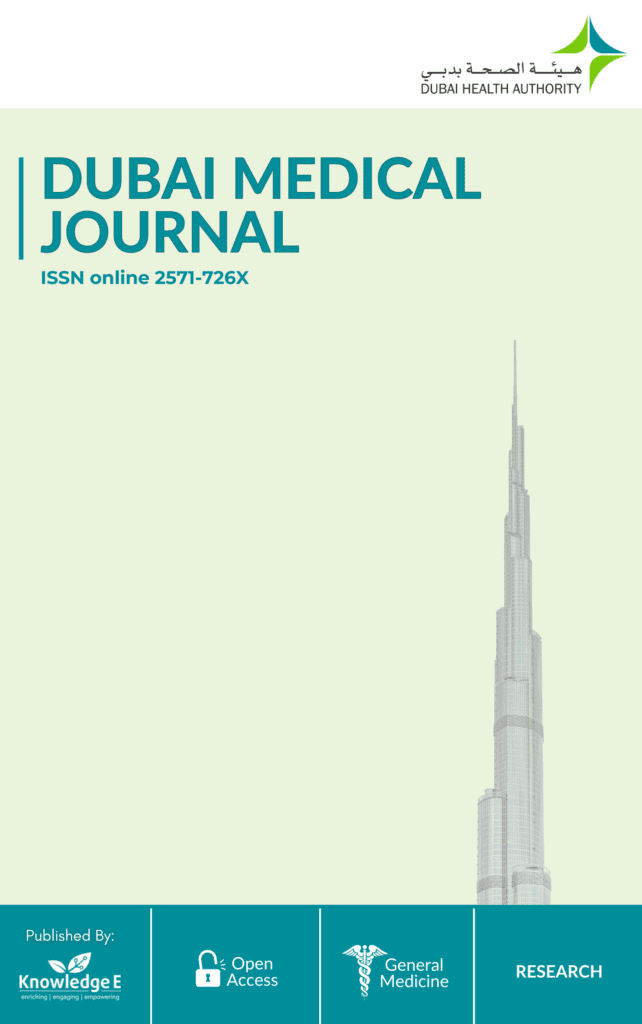
Dubai Medical Journal
ISSN: 2571-726X
Pioneering research in medicine, health sciences, nursing, pharmaceuticals, and laboratory work
Exploring the Connection Between Family History of Seizures and Post-traumatic Brain Injury Seizure Types: A Retrospective Study
Published date: Oct 30 2024
Journal Title: Dubai Medical Journal
Issue title: Dubai Medical Journal (DMJ): Volume 7 Issue 1
Pages: 16 - 23
Authors:
Abstract:
Background: Traumatic brain injury (TBI) is one of the most common presentations to emergency departments and is associated with seizures carrying different significance at different stages following injury. The occurrence of seizures after head injury is a recognized complication of TBI and has been demonstrated to worsen functional outcomes significantly. Despite previous studies identifying various PTS risk factors, our understanding remains limited, particularly regarding familial seizure history.
Materials and Methods: A retrospective study was conducted at King Abdullah University Hospital (KAUH), Jordan, examining 1934 TBI cases from 2017 to 2023, identifying 118 patients with confirmed post-traumatic seizures.
Results: This study involved 118 TBI patients, aged between 2 and 86 years (median 21.5 years), with 74.6% male and 25.4% female. A family history of seizures was reported by 23.7% of patients. Intracerebral hemorrhage (ICH) (52.5%) and subarachnoid hemorrhage (SAH) (38.1%) were the predominant trauma types. Generalized tonicclonic (GTCs) seizures (69.5%) and focal seizures (30.5%) were observed post-TBI. Among 28 patients with a family history of seizures, no evidence of association was observed between the family history and post-traumatic seizure types (GTCs or focal seizures), this was confirmed by performing Chi-square tests (p = 0.9841) and logistic regression analysis (p = 0.79).
Conclusion: Our findings suggest that there is no evidence of the association between family history and post-traumatic seizure types, implying that a specialized approach for patients with positive family histories may not be warranted. Larger studies are recommended for further validation.
Keywords: TBI, PTS, seizure, epilepsy, family history
References:
[1] Fordington S, Manford M. A review of seizures and epilepsy following traumatic brain injury. J Neurol. 2020 Oct;267(10):3105–3111.
[2] Asikainen I, Kaste M, Sarna S. Early and late posttraumatic seizures in traumatic brain injury rehabilitation patients: Brain injury factors causing late seizures and influence of seizures on longterm outcome. Epilepsia. 1999 May;40(5):584–589.
[3] Anwer F, Oliveri F, Kakargias F, Panday P, Arcia Franchini AP, Iskander B, et al. Post-traumatic seizures: A deep-dive into pathogenesis. Cureus. 2021 Apr;13(4):e14395.
[4] DeGrauw X, Thurman D, Xu L, Kancherla V, DeGrauw T. Epidemiology of traumatic brain injuryassociated epilepsy and early use of anti-epilepsy drugs: An analysis of insurance claims data, 2004- 2014. Epilepsy Res. 2018 Oct;146:41–49.
[5] Frey LC. Epidemiology of posttraumatic epilepsy: A critical review. Epilepsia. 2003;44 s10:11–17.
[6] Annegers JF, Grabow JD, Groover RV, Laws ER Jr, Elveback LR, Kurland LT. Seizures after head trauma: A population study. Neurology. 1980 Jul;30(7 Pt 1):683–689.
[7] Salazar AM, Jabbari B, Vance SC, Grafman J, Amin D, Dillon JD. Epilepsy after penetrating head injury. I. Clinical correlates: A report of the Vietnam Head Injury Study. Neurology. 1985 Oct;35(10):1406–1414.
[8] Steinlein OK. Genetics and epilepsy. Dialogues Clin Neurosci. 2008;10(1):29–38.
[9] Guerrini R, Casari G, Marini C. The genetic and molecular basis of epilepsy. Trends Mol Med. 2003 Jul;9(7):300–306.
[10] Lamar CD, Hurley RA, Rowland JA, Taber KH. Post-traumatic epilepsy: Review of risks, pathophysiology, and potential biomarkers. J Neuropsychiatry Clin Neurosci. 2014 Apr;26(2):iv-113.
[11] Kodankandath TV, Theodore D, Samanta D. Generalized tonic-clonic seizure, in StatPearls. 2024: Treasure Island (FL) ineligible companies. Disclosure: Danny Theodore declares no relevant financial relationships with ineligible companies. Disclosure: Debopam Samanta declares no relevant financial relationships with ineligible companies.
[12] da Silva AM, Nunes B, Vaz AR, Mendonça D. Posttraumatic epilepsy in civilians: Clinical and electroencephalographic studies. Acta Neurochir Suppl (Wien). 1992;55:56–63.
[13] Tunthanathip T. Chapter 8: Seizures in traumatic brain injury: A focus on cellular aspects. In: Rajendram R, Preedy VR, Martin CR, editors. Cellular, molecular, physiological, and behavioral aspects of traumatic brain injury. Academic Press; 2022. pp. 95–105.
[14] Zhao Y, Wu H, Wang X, Li J, Zhang S. Clinical epidemiology of posttraumatic epilepsy in a group of Chinese patients. Seizure. 2012 Jun;21(5):322–326.
[15] Bögli SY, Wang S, Romaguera N, Schütz V, Rafi O, Gilone M, et al. Impact of seizures and status epilepticus on outcome in patients with aneurysmal subarachnoid hemorrhage. Neurocrit Care. 2022 Jun;36(3):751–759.
[16] Labak CM, Shammassian BH, Zhou X, Alkhachroum A. Multimodality monitoring for delayed cerebral ischemia in subarachnoid hemorrhage: A mini review. Front Neurol. 2022 Apr;13:869107.
[17] Rhoney DH, Tipps LB, Murry KR, Basham MC, Michael DB, Coplin WM. Anticonvulsant prophylaxis and timing of seizures after aneurysmal subarachnoid hemorrhage. Neurology. 2000 Jul;55(2):258–265.
[18] Sundaram MB, Chow F. Seizures associated with spontaneous subarachnoid hemorrhage. Can J Neurol Sci. 1986 Aug;13(3):229–231.
[19] Gottesman RF, Komotar R, Hillis AE. Neurologic aspects of traumatic brain injury. Int Rev Psychiatry. 2003 Nov;15(4):302–309.
[20] Greene KA, Jacobowitz R, Marciano FF, Johnson BA, Spetzler RF, Harrington TR. Impact of traumatic subarachnoid hemorrhage on outcome in nonpenetrating head injury. Part II: Relationship to clinical course and outcome variables during acute hospitalization. J Trauma. 1996 Dec;41(6):964–971.